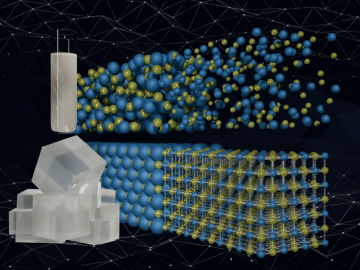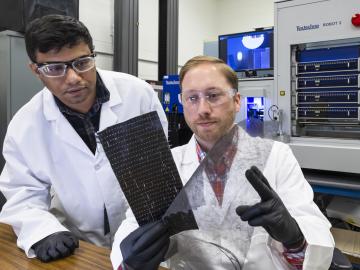
Filter News
Area of Research
- Advanced Manufacturing (7)
- Biology and Environment (54)
- Biology and Soft Matter (1)
- Computational Biology (1)
- Computational Engineering (2)
- Computer Science (6)
- Electricity and Smart Grid (3)
- Energy Science (90)
- Functional Materials for Energy (1)
- Fusion and Fission (26)
- Fusion Energy (15)
- Isotopes (25)
- Materials (83)
- Materials for Computing (7)
- Mathematics (1)
- National Security (26)
- Neutron Science (122)
- Nuclear Science and Technology (18)
- Quantum information Science (1)
- Sensors and Controls (1)
- Supercomputing (50)
News Topics
- (-) Composites (35)
- (-) Fusion (66)
- (-) Grid (74)
- (-) Isotopes (62)
- (-) Machine Learning (68)
- (-) Neutron Science (171)
- (-) Physics (69)
- 3-D Printing/Advanced Manufacturing (146)
- Advanced Reactors (40)
- Artificial Intelligence (131)
- Big Data (79)
- Bioenergy (112)
- Biology (128)
- Biomedical (73)
- Biotechnology (39)
- Buildings (74)
- Chemical Sciences (86)
- Clean Water (33)
- Computer Science (226)
- Coronavirus (48)
- Critical Materials (29)
- Cybersecurity (35)
- Education (5)
- Element Discovery (1)
- Emergency (4)
- Energy Storage (114)
- Environment (218)
- Exascale Computing (67)
- Fossil Energy (8)
- Frontier (64)
- High-Performance Computing (130)
- Hydropower (12)
- Irradiation (3)
- ITER (9)
- Materials (157)
- Materials Science (158)
- Mathematics (12)
- Mercury (12)
- Microelectronics (4)
- Microscopy (56)
- Molten Salt (10)
- Nanotechnology (64)
- National Security (86)
- Nuclear Energy (122)
- Partnerships (68)
- Polymers (35)
- Quantum Computing (53)
- Quantum Science (93)
- Security (31)
- Simulation (65)
- Software (1)
- Space Exploration (26)
- Statistics (4)
- Summit (71)
- Transportation (103)
Media Contacts

Scientists have developed a new machine learning approach that accurately predicted critical and difficult-to-compute properties of molten salts, materials with diverse nuclear energy applications.

Researchers at ORNL have developed an innovative new technique using carbon nanofibers to enhance binding in carbon fiber and other fiber-reinforced polymer composites – an advance likely to improve structural materials for automobiles, airplanes and other applications that require lightweight and strong materials.

Van Graves, an engineering manager at ORNL, is celebrating 40 years of dedicated service leading a diverse range of prominent engineering projects at ORNL and internationally.

As the focus on energy resiliency and competitiveness increases, the development of advanced materials for next-generation, commercial fusion reactors is gaining attention. A recent paper examines a promising candidate for these reactors: ultra-high-temperature ceramics, or UHTCs.

Using the Frontier supercomputer, a team of researchers from the Massachusetts Institute of Technology conducted large-scale calculations to chart the isospin density of a neutron star across a range of conditions. Their work provides new insights into how pressure and density interact within neutron stars, offering important predictions about their inner workings.

Analyzing massive datasets from nuclear physics experiments can take hours or days to process, but researchers are working to radically reduce that time to mere seconds using special software being developed at the Department of Energy’s Lawrence Berkeley and Oak Ridge national laboratories.

Scientists at ORNL have developed a vacuum-assisted extrusion method that reduces internal porosity by up to 75% in large-scale 3D-printed polymer parts. This new technique addresses the critical issue of porosity in large-scale prints but also paves the way for stronger composites.
Researchers at Oak Ridge National Laboratory have developed a modeling method that uses machine learning to accurately simulate electric grid behavior while protecting proprietary equipment details. The approach overcomes a key barrier to accurate grid modeling, helping utilities plan for future demand and prevent blackouts.
Daniel Jacobson, distinguished research scientist in the Biosciences Division at ORNL, has been elected a Fellow of the American Institute for Medical and Biological Engineering, or AIMBE, for his achievements in computational biology.
Troy Carter, director of the Fusion Energy Division at Oak Ridge National Laboratory, leads efforts to make fusion energy a reality, overseeing key projects like MPEX and fostering public-private collaborations in fusion research.


